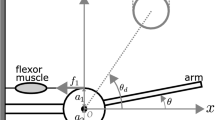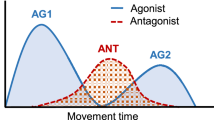Abstract
According to the equilibrium trajectory hypothesis, multi-joint arm movements are achieved by gradually shifting the hand equilibrium positions defined by the neuromuscular activity. The magnitude of the force exerted on the arm, at any time, depends on the difference between the actual and equilibrium hand positions and the stiffness and viscosity about the equilibrium position. The purpose of this paper is to test the validity and implications of this hypothesis in the context of reaching movements. A mathematical description of the behavior of an arm tracking the equilibrium trajectory was developed and implemented in computer simulations. The joint stiffness parameters used in these simulations were derived from experimentally measured static stiffness values. The kinematic features of hand equilibrium trajectories which were derived from measured planar horizontal movements gave rise to the suggestion that the generation of reaching movements involves explicit planning of spatially and temporally invariant hand equilibrium trajectories. This hypothesis was tested by simulating actual arm movements based on hypothetical equilibrium trajectories. The success of the predicted behavior in capturing both the qualitative features and the quantitative kinematic details of the measured movements supports the equilibrium trajectory hypothesis. The control strategy suggested here may allow the motor system to avoid some of the complicated computational problems associated with multi-joint arm movements.
Similar content being viewed by others
References
Abend W, Bizzi E, Morasso P (1982) Human arm trajector formation. Brain 105:331–348
Asatryan DG, Feldman AG (1965) Functional tuning of nervous system with control of movement or maintenance of a steady posture. I. Mechanographic analysis of the work of the joint on execution of a postural task. Biophysics 10:925–935
Atkeson CG, Saund E (1984) Estimation of equilibrium position, stiffness and viscosity during single joint arm movement. Neuroscience 10:335 (abstr)
Bizzi E, Polit A, Morasso P (1976) Mechanisms underlying achievement of final head position. J Neurophysiol 39:435–444
Bizzi E, Accornero N, Chapple W, Hogan N (1982) Arm trajectory formation. Exp Brain Res 46:139–143
Bizzi E, Accornero N, Chapple W, Hogan N (1984) Posture control and trajectory formation during arm movement. J Neurosci 4:2738–2744
Cannon S, Zahalak GI (1982) The mechanical behavior of active human skeletal muscle in small oscillations. J Biomech 15:111–121
Feldman AG (1966) Functional tuning of nervous system with control of movement or maintenance of a steady posture. II. Controllable parameters of the muscle. Biophysics 11:565–578
Feldman AG (1974) Change in the length of the muscle as a consequence of a shift in equilibrium in the muscle-load system. Biophysics 19:544–548
Feldman AG (1980) Superposition of motor programs. I. Rhythmic forearm movements in man. Neuroscience 5:81–90
Flash T, Hogan N (1985) The coordination of arm movements: an experimentally confirmed mathematical model. J Neurosci 7:1688–1703
Flash T, Mussa-Ivaldi FA (1984) Inferring movement and muscle synergies from multi-joint arm posture. Neuroscience 10:635 (abstr)
Georgopoulos AP (1986) On reaching. Annu Rev Neurosci 9:147–170
Ghez C, Martin JH (1982) The control of rapid limb movement in the cat. III. Agonist-Antagonist coupling. Exp Brain Res 45:115–125
Gielen CCAM, Houk JC (1984) Nonlinear viscosity of human wrist. J Neurophysiol 52:553–569
Hallett M, Marsden CD (1979) Ballistic flexion movements of the human thumb. J Physiol 294:33–50
Hatze H (1979) A model for the computational determination of parameter values of anthropomorphic segments. South African C.S.I.R. Technical Report TWISK 79
Hoffer JA, Andreassen S (1981) Regulation of soleus muscle stiffness in premammillary cats: intrinsic and reflex components. J Neurophysiol 45:267–285
Hogan N (1984) An organizing principle for a class of voluntary movements. J Neurosci 4:2745–2754
Hogan N (1985) The mechanics of multi-joint posture and movement. Biol Cybern 52:315–331
Hollerbach JM (1982) Computers, brains and the control of movement. Trends Neurosci 5:189–192
Hollerbach JM, Flash T (1982) Dynamic interactions between limb segments during planar arm movement. Biol Cybern 44:67–77
Joyce GC, Rack PMH, Westbury DR (1969) The mechanical properties of cat soleus muscle during controlled lengthening and shortening movements. J Physiol 204:461–474
Kelso JAS, Holt KG (1980) Exploring a vibratory systems analysis of human movement production. J Neurophysiol 43:1183–1196
Lacquaniti F, Licata F, Soechting JF (1982) The mechanical behavior of the human forearm in response to transient perturbations. Biol Cybern 44:35–46
Lestienne F (1979) Effects of inertial load and velocity on the bracking process of voluntary limb movement. Exp Brain Res 35:407–418
MacKay WA, Crammond DJ, Kwan HC, Murphy JT (1986) Measurements of human forearm viscoelasticity. J Biomech 19:231–238
Morasso P (1981) Spatial control of arm movements. Exp Brain Res 42:223–227
Mussa-Ivaldi FA, Hogan N, Bizzi E (1985) Neural, mechanical and geometric factors subserving arm posture in humans. J Neurosci 5:2732–2743
Nichols TR, Houk JC (1976) Improvement in linearity and regulation of stiffness that results from actions of stretch reflex. J Neurophysiol 39:119–142
Polit A, Bizzi E (1979) Characteristics of motor programs underlying arm movements in monkeys. J Neurophysiol 42:183–194
Rack PMH, Westbury DR (1969) The effects of length and stimulus rate on tension in the isometric cat soleus muscle. J Physiol 204:443–460
Author information
Authors and Affiliations
Rights and permissions
About this article
Cite this article
Flash, T. The control of hand equilibrium trajectories in multi-joint arm movements. Biol. Cybern. 57, 257–274 (1987). https://doi.org/10.1007/BF00338819
Received:
Issue Date:
DOI: https://doi.org/10.1007/BF00338819




